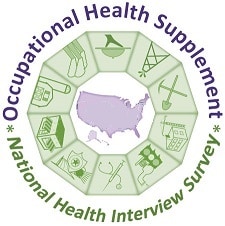Worker Health Information from the National Health Interview Survey

About the Survey
Every year, for over 50 years, the National Health Interview Survey has been conducted. It is used to monitor the health of the nation, as it collects information by interviewing American households. The survey monitors trends on a variety of topics, including health status, health care access, and progress towards achieving national health objectives.
Learn more about the questionnaires, data, and survey methods.
Assessing Worker Health Using the NHIS Core Survey Data
From 1997-2017, the annual NHIS core Sample Adult and Family Questionnaires included questions about employment status and several other factors related to the respondent’s current job, such as industry (type of business) and occupation (type of job). These data are used to study general trends in worker health.
NIOSH compiled NHIS core data on the prevalence of many general health outcomes among workers. You can assess the data using Worker Health Charts, our data visualization tool. Worker Health Charts allow you to assess how worker health varies by demographic or industry group. The health outcomes include:
- Chronic Conditions
- Musculoskeletal Health
- Health Behaviors
- Health Status and Physical Activity Limitations
- Healthcare Utilization/Access
- Working Conditions and Employment Benefits
See the Core questions included in the Worker Health Charts.
Detailed Worker Health Information (Occupational Health Supplements)
NIOSH sponsored supplemental work-related questions in the 2010 and 2015 surveys. Known as the “occupational health supplements” (OHS), these questions collected more in-depth information on the prevalence of work-related health conditions and exposures to potential psychological and physical job hazards in the U.S. working population. The OHS questions were included as part of the Sample Adult questionnaires.
Data from the supplements can be combined with other data from the NHIS questionnaires to analyze relationships between occupational exposures and other common health conditions and interactions between work-related and non-work-related factors (e.g., tobacco use, physical activity).[/vc_column_text][/vc_column][/vc_row]
Prior to 2010, the last NHIS-OHS was conducted in 1988. The 2010 NHIS-OHS included similar questions to the 1988 supplement about dermatitis, carpal tunnel syndrome and occupational asthma. Questions on other topics (e.g., psychosocial exposures) were adapted from other validated survey instruments, where possible.
The 2015 NHIS-OHS focused on carpal tunnel syndrome and low back pain in addition to potential psychological and physical occupational hazards and the availability and use of workplace health promotion programs. Many questions were repeated from the 2010 OHS, but some questions were modified, and others were new to the 2015 OHS.
See the 2015 OHS questions included in the Worker Health Charts
Please note the following about the NHIS data:
Strengths
- NHIS is a large well-established household survey of health outcomes, health behaviors, and healthcare access among a representative sample of the civilian noninstitutionalized population of the U.S.
- The NHIS has been conducted annually since 1957. From 1997-2018, the annual NHIS core Sample Adult and Family Questionnaires included questions about employment status and several other factors related to the respondent’s current job, such as industry (type of business) and occupation (type of job). These data can be used to study general trends in worker health.
- The sample size is fairly large (approximately 15,000 – 20,000 currently employed individuals in each year of data).
- Consistent industry and occupation (I&O) simple and detailed recodes (categories) have been included in the public use NHIS datasets from 2004-2018, so several years of data can be combined to increase the size of I&O subsamples.
Limitations
- NHIS uses a cross-sectional study design; therefore, causal inferences cannot be made.
- I&O are not part of the sampling design; therefore, NHIS data are not representative of individual industries and occupations.
- A redesigned NHIS questionnaire was launched in 2019. I&O are now part of a rotating core module that will only be asked 2 out of every 3 years (i.e., 2020 and 2021), so only 2 years of I&O data will be able to be combined.
- NHIS data are based on self-reported responses; therefore, response bias (e.g. recall, social desirability) may be present.
- Information on health outcomes is not validated by a health professional or medical records; therefore, responses may be subject to misclassification.
- There may be some misclassification of I&O due to non-specific responses.
- The NHIS is not specifically designed to measure small subpopulations of workers.
- Sampling error is likely to have a substantial impact on statistics from small subpopulations such as workers in nonstandard work arrangements.
- In addition, because it is household based, NHIS may underrepresent low income earners and earners in agriculture and mining.
- We recommend presenting both point estimates and confidence intervals so that the reader understands the impact of sampling error.
